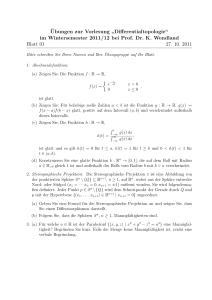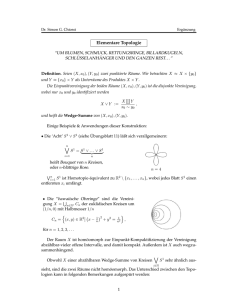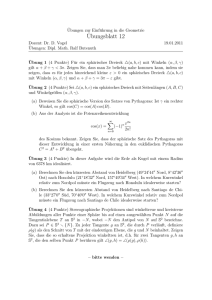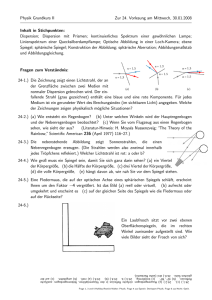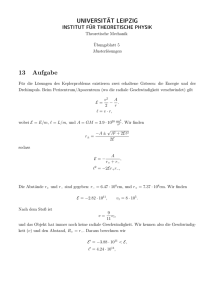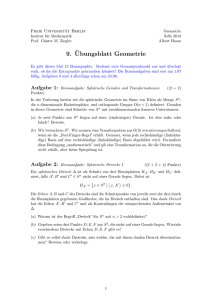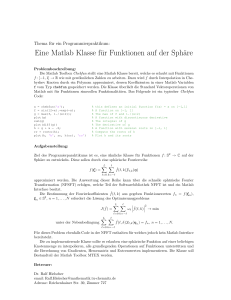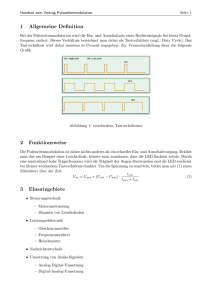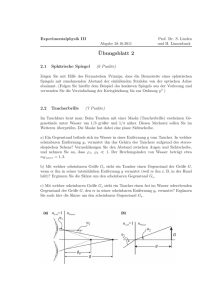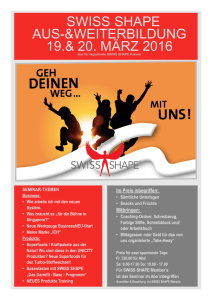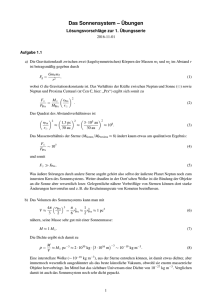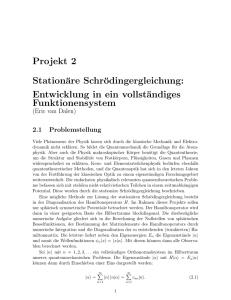Geometrie – ¨Ubungsblatt 10
Werbung
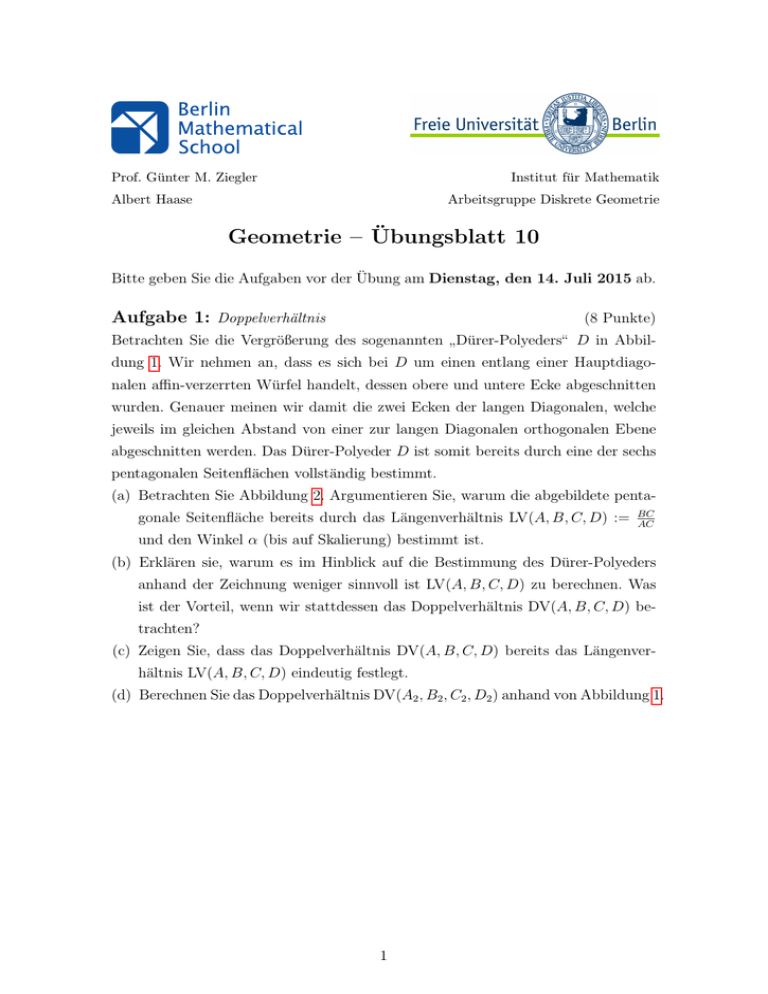
Prof. Günter M. Ziegler
Institut für Mathematik
Albert Haase
Arbeitsgruppe Diskrete Geometrie
Geometrie – Übungsblatt 10
Bitte geben Sie die Aufgaben vor der Übung am Dienstag, den 14. Juli 2015 ab.
Aufgabe 1: Doppelverhältnis
(8 Punkte)
Betrachten Sie die Vergrößerung des sogenannten Dürer-Polyeders“ D in Abbil”
dung 1. Wir nehmen an, dass es sich bei D um einen entlang einer Hauptdiagonalen affin-verzerrten Würfel handelt, dessen obere und untere Ecke abgeschnitten
wurden. Genauer meinen wir damit die zwei Ecken der langen Diagonalen, welche
jeweils im gleichen Abstand von einer zur langen Diagonalen orthogonalen Ebene
abgeschnitten werden. Das Dürer-Polyeder D ist somit bereits durch eine der sechs
pentagonalen Seitenflächen vollständig bestimmt.
(a) Betrachten Sie Abbildung 2. Argumentieren Sie, warum die abgebildete pentagonale Seitenfläche bereits durch das Längenverhältnis LV(A, B, C, D) :=
BC
AC
und den Winkel α (bis auf Skalierung) bestimmt ist.
(b) Erklären sie, warum es im Hinblick auf die Bestimmung des Dürer-Polyeders
anhand der Zeichnung weniger sinnvoll ist LV(A, B, C, D) zu berechnen. Was
ist der Vorteil, wenn wir stattdessen das Doppelverhältnis DV(A, B, C, D) betrachten?
(c) Zeigen Sie, dass das Doppelverhältnis DV(A, B, C, D) bereits das Längenverhältnis LV(A, B, C, D) eindeutig festlegt.
(d) Berechnen Sie das Doppelverhältnis DV(A2 , B2 , C2 , D2 ) anhand von Abbildung 1.
1
F. Futamura et al.
Downloaded by [FU Berlin] at 07:24 03 December 2014
2
Figure 1.
Albrecht Dürer’s Melencolia I (upper left) and a blowup of the enigmatic polyhedron.
Abbildung 1: Albrecht Dürer, Melencolia I und Vergrößerung des Dürer-Polyeders.
(a cube is such a figure). Then, with the longest diagoJournal
of Mathematics and the Arts
completely determined by the shape of one of the pentago3
nal faces; hence, many authors describe their model of the
solid by describing the shape of one of these pentagons.
In addition
A to rules, the game should have some method
for scoring various attempts at it, at least in an informal
way. First of all, it makes no sense to play the game if we
nal held vertically, congruent tetrahedra are cropped off
the top and bottom by horizontal planes, leaving congruDürer was such a poor draftsman
we can
ent that
equilateral
triangles as the top and bottom faces. The
faceswe
– the truncated rhombi – are thus congruent,
e the engraving and conjecture other
any six
shape
bilaterally symmetric pentagons. The shape of the solid is
erefore require that a proposed model of the
have a shape that is close to that derived by
analysis of the engraving. In addition to reer as an artist, we must acknowledge his repmathematician. In the words of the respected
an Morris Kline, ‘. . . of all the Renaissance
est mathematician was the German Albrecht
4, p. 233]. Among other things, Dürer owned
uclid and wrote a well-respected treatise on
deed, the title of this treatise, Underweysung
mit dem Zirckel und Richtscheyt in Linien,
Gantzen Corporen [Instruction in Measureompass and Straightedge of Lines, Surfaces,
odies] [1], suggests that Dürer may have deolid body’ in Melencolia I byAbbildung
using ‘compass2:
dge’ to construct its definitive ‘surfaces’ – the
aces. Our model, presented in the next section,
ay this could have been done. Thus, we assume
corporated some kind of interesting mathemathips into the design of the solid, rather than just
il he found something that looked pleasing to
osed model of the solid should include the
f such relationships.
B
C
α
D
Figure 2.
The parameters α and λ determine the shape of the
Schematische
einer
Seitenfläche
truncated rhombicAnsicht
face and hence
the shape
of the solid. des Dürer-Polyeders.
ratio BC/AC. Letting λ = (AB, CD), we have
AC BC + AC
AC BD
=
λ = (AB, CD) =
BC
AD
BC
2AC
!
"
1
1
1+
.
=
2
BC/AC
Solving (1) for BC/AC gives
2
(1)
Aufgabe 2: Sphärische n-Ecke
(6 Punkte)
Für n ≥ 1 ist ein sphärisches (n+1)-Eck Cn+1 ⊂ S 2 mit den Ecken v0 , v1 , . . . , vn die
Menge, die sich als Schnitt von positiven abgeschlossenen Halbsphären H0+ , H2+ , . . .
+
. . . , H2n
ergibt, welche die Eigenschaft haben, dass vi und vi+1 im Großkreis Hi
liegen und die Punkte {v0 , v1 , . . . , vi−1 , vi+2 , . . . , vn } in der offenen positiven Halb+
sphäre Hi,>
enthalten sind. Eine Seite vi vi+1 von Cn+1 ist der Schnitt von Hi mit
Cn+1 . Wir nennen Cn+1 regulär, falls alle Seiten die gleiche Länge haben und alle
Winkel gleich sind.
Zeigen Sie, dass reguläre sphärische n-Ecke für n = 3, 4 und 5 mit Winkel 120◦ existieren und berechnen Sie ihre Kantenlängen und Flächeninhalte. Gibt es reguläre
sphärische 6-Ecke mit Winkel 120◦ ?
Aufgabe 3: Sphärische Transformationen
(4 Punkte)
Es seien v1 , v2 , v3 sowie w1 , w2 , w3 die Ecken von zwei sphärischen Dreiecken mit der
Eigenschaft, dass |vi − vj | = |wi − wj |. Zeigen Sie, dass eine Orthogonaltransformation f ∈ O(3) existiert, welche vi auf wi abbildet für i = 1, 2, 3.
Aufgabe 4: Winkelhalbierende
(2 Punkte)
Gegeben sei eine sphärisches Dreieck ∆ mit Ecken v1 , v2 , v3 . Definieren Sie zunächst
den Begriff Winkelhalbierende“ und zeigen Sie, dass sich die drei Winkelhalbieren”
den in einem Punkt schneiden.
3
